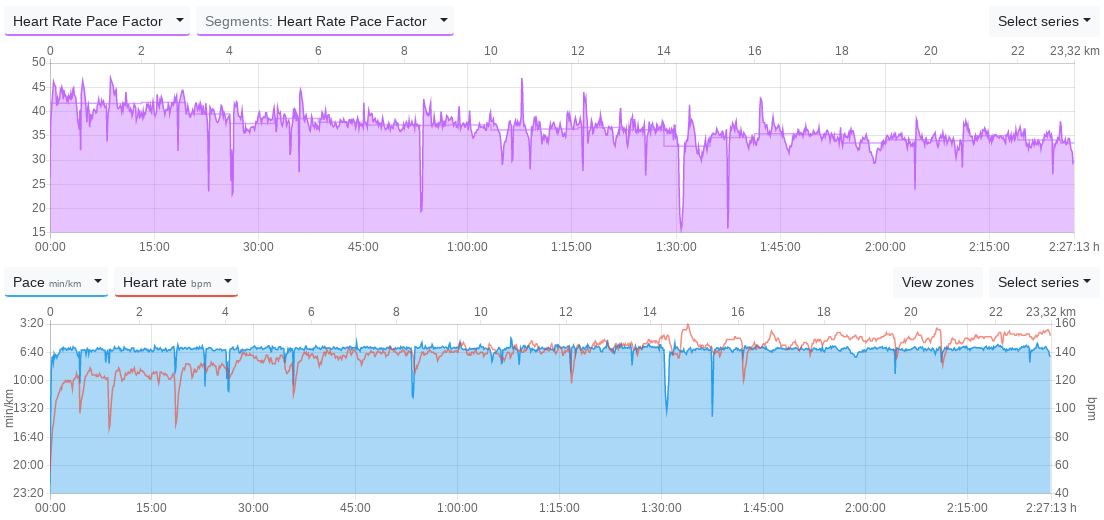The Heart Rate Pace Factor and the Heart Rate Power Factor can be displayed as time series in the series view of your training.
With this, you are able to find out, if you are slowly getting tired during a run, a bike ride or a swim session. This would be the case if the Heart Rate Pace Factor gets lower over time. If the factor drops only slightly or not at all, this is a sign of very good fitness during longer sessions.
How much the Heart Rate Pace Factor drops during a longer training session gives you an indication of your endurance capacity and fitness.

This long run in marathon preparation became quite exhausting at the end, which can be seen in the steady drop of the Heart Rate Pace Factor, at a constant pace.
For longer races like a marathon or half marathon, the efficiency should be visibly lower towards the end of the race, as you will become increasingly exhausted. If this is not the case, you have either run too slowly or have been running inhumanly fast from the beginning on.
Uneven passages, ascents, permanent descents when running, sand or too much beer make the efficiency shrink, the factor decreases.

This half marathon offers hilly passages and stairs in the middle of the course as a surprise. The efficiency and therefore the heart rate pace factor decreases, but recovers afterwards, thanks to good fitness.
What are these efficiency metrics?
These two efficiency metrics are formed from 2 reference values, which combine an input power value on one side and an output power value on the other side. This way a factor can be formed, which in turn can be compared with other values like the cadence or simply the distance of an activity.
The input power is the cardiological work, which is formed from the current heart rate at the maximum possible heart rate.
The output power is either the speed or pace or the wattage if you have a power meter such as a Stryd.
The Heart Rate Pace Factor is formed from speed and cardiological capacity.
The Heart Rate Power Factor is formed from wattage and cardiological capacity.
Which one is the more suitable value depends on the application. Provided you have a power meter to be able to view the heart rate power factor.
In general, the Heart Rate Power Factor provides more accurate, real, body related efficiency values. For example, if you are doing a trail run in hilly terrain, you will find that the efficiency varies greatly related to speed. Which is not surprising given the constant changes in ascent and descent. If you go uphill, it moves very inefficiently in relation to time. On the other hand, the efficiency, related to the wattage, does not fluctuate that much, because this value is purely power related and has no time component. Depending on what you want to determine, each factor has its right to exist.
Find more efficiency indicators in the glossary.
What does your training collection look like?
You could browse through your training collection and see how it behaves with you. For example, do you find many long training sessions where your efficiency factors remain the same? Then you are probably quite fit! If you find a training session where the efficiency even increases over time, then please send me an email. Maybe you had to warm up first! :-)
